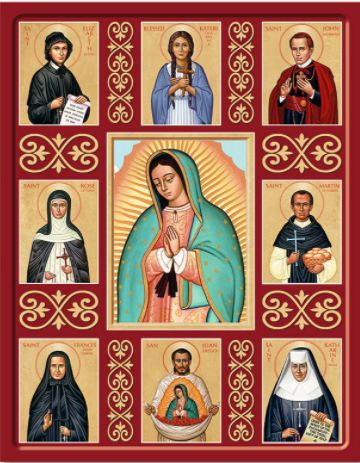A Roman Catholic Parish
The Personal Ordinariate of S. Peter
Eutaw Street and Madison Avenue
Baltimore, Maryland
Rev. Albert Scharbach, Pastor
Rev. Michael Heinle, Celebrant
Andrew Johnson, Organist and Music Director
ALL SAINTS
Sunday
November 1, 2020
10:00 AM
This service will be livecast
_________________
Organ Prelude
“In Paradisum,” Gabriel Fauré
“In Paradisum” Gabriel Fauré (1845-1924) This morning’s prelude is a transcription of the last movement from Fauré’s Requiem (1887), whose comforting lyrics speak for
themselves: May the angels lead you into paradise; may the martyrs receive you at your arrival and lead you to the holy city, Jerusalem. May choirs of angels receive you and with Lazarus, once a poor man, may you have eternal rest.
_________
Organ Postlude
“O Day of Peace,” C.H.H. Parry
O day of peace that dimly shines through all our hopes and prayers and dreams,
Guide us to justice, truth, and love, delivered from our selfish schemes.
May swords of hate fall from our hands, our hearts from envy find release,
Till by God’s grace our warring world shall see Christ’s promised reign of peace.
Then shall the wolf dwell with the lamb, nor shall the fierce devour the small;
As beasts and cattle calmly graze, a little child shall lead them all.
Then enemies shall learn to love, all creatures find their true accord;
The hope of peace shall be fulfilled, for all the earth shall know the Lord.
_______________
Offertory Anthem
“O quam gloriosum,” Tomás Luis de Victoria
O quam gloriosum est regnum,
in quo cum Christo gaudent omnes Sancti,
amicti stolis albis,
sequuntur Agnum, quocumque ierit.
O how glorious is the kingdom,
in which all the saints rejoice with Christ,
arrayed in white robes,
they follow the Lamb, wherever He goes.
: “O quam gloriosum” Tomás Luis de Victoria (1548-1611), who was the premiere Spanish composer of Renaissance polyphony in the 16th century. The opening three chords seem to expand like the heavens. Then, Victoria portrays the joyful saints with rapid ascending scalar motion below a floating soprano line.
________
Communion Anthem
“At the River,” arr. Aaron Copland
Shall we gather by the river,
Where bright angel’s feet have trod,
With its crystal tide forever
Flowing by the throne of God?
Yes, we’ll gather by the river,
The beautiful, the beautiful river,
Gather with the saints by the river
That flows by the throne of God.
Soon we’ll reach the shining river,
Soon our pilgrimage will cease,
Soon our happy hearts will quiver
With the melody of peace.
Yes, we’ll gather by the river,
The beautiful, the beautiful river,
Gather with the saints by the river
That flows by the throne of God.
Aaron Copland (1900-1990) who redefined and elevated American music in the 20th century. This piece, like many of his other works, is based on an American folk tune. Copland is careful to leave the hymn melody nearly unchanged and instead creates a new musical landscape around it which is both gentle and supportive of the soloist.
__________________
Hymns
For all the saints is by the Anglican bishop William Walsham How (1823—1897), who was a great friend of the poor of his diocese, and was known variously as ‘the children’s bishop’, ‘the poor man’s bishop’ and ‘the omnibus bishop’ (the last referring to his preferred means of travel about his diocese). This hymn derives much of its power from its ability to capture the spirit of the Church Militant here on earth, using imagery from the book of Revelation. Vaughan Williams composed the tune SINE NOMINE (‘without a name’) for this hymn. It has been suggested that the name of the tune refers to the countless number of saints who are not remembered by name but who are part of the ‘glorious company’.
Jerusalem, my happy home has a complicated history. It may have been written by a 16th century Catholic priest “F. B. P” (¿Francis Baker Porter?) imprisoned in the Tower and it may be based on The Meditations of St. Augustine. It exists in several versions; the one we use was said to be the favorite hymn of Elizabeth Ann Seton. As adults, we know we live in a vale of tears: the disappointments of life, the sickness and death of friends and family, the destruction that evil works in God’s creation. This world as it now exists is not our home, which we will find in the transfigured world of the New Creation. The disharmony of the present age will be replaced by the harmony of heaven, symbolized by music, the new song, canticum novum, that we will forever sing. LAND OF REST is an American folk tune with roots in the ballads of northern England and Scotland. It was known throughout the Appalachians; a shape-note version of the tune was published in The Sacred Harp (1844).
Joy and triumph everlasting is a translation by the English poet laureate Robert Bridges (1844-1930) of Adam of St. Victor’s (1112-1146) hymn Superne matris gaudia. The first verse contains a paradox: ‘For that pure immortal gladness / all our feast days mourn and sigh’. The very act of rejoicing at annual festivals, fixed points in earthly time, causes us to mourn for a place where there will be no time, and no feast-days – ‘no ends nor beginnings but one equal eternity’, as John Donne has it. The tune GENEVAN 42 is an adaptation by Louis Bourgeois (1510–1559) of a tune by Claude Goudimel (1501–1572), a French Calvinist who was killed in the St. Bartholomew’s Day Massacre.
